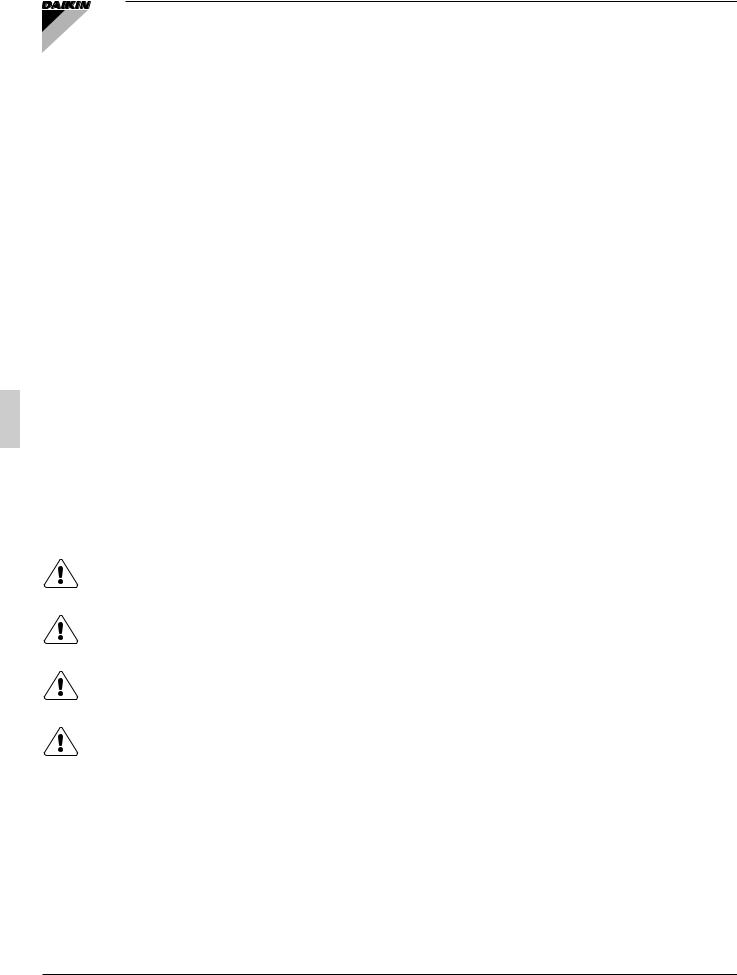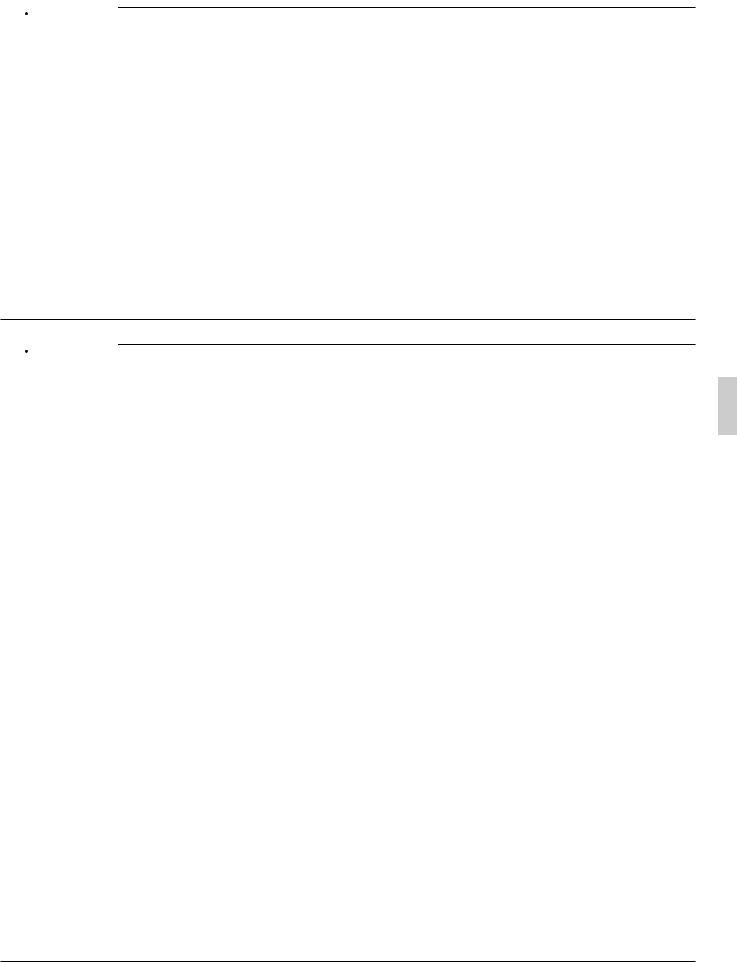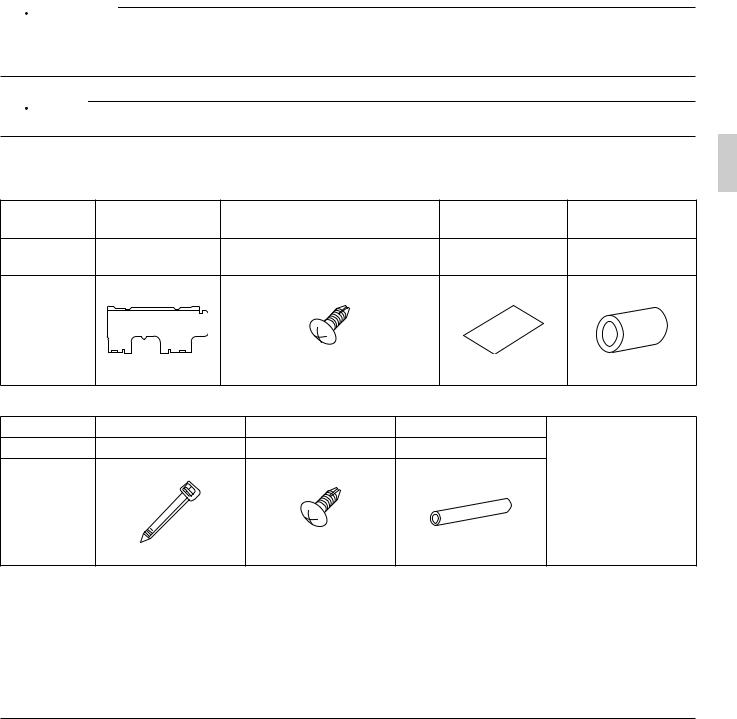Daikin FAQ18PVJU, FAQ24PVJU User Manual

INSTALLATION MANUAL
SPLIT SYSTEM Air Conditioner
MODELS
Wall-mounted type
FAQ18PVJU
FAQ24PVJU
English
Français
Read these instructions carefully before installation. Keep this manual in a handy place for future reference. This manual should be left with the equipment owner.
Español
Lire soigneusement ces instructions avant I’installation. Concerver ce manuel à portée de main pour référence ultérieure.
Ce manuel doit être donné au propriétaire de l’équipement.
Lea cuidadosamente estas instrucciones antes de instalar. Guarde este manual en un lugar a mano para leer en caso de tener alguna duda.
Este manual debe permanecer con el propietario del equipo.

SPLIT SYSTEM Air Conditioner |
Installation manual |
|
|
CONTENTS
1.SAFETY CONSIDERATIONS ………………………………………………………………1
2.BEFORE INSTALLATION ……………………………………………………………………3
3.SELECTING INSTALLATION SITE …………………………………………………………5
4.INDOOR UNIT INSTALLATION………………………………………………………………7
5.REFRIGERANT PIPING WORK ………………………………………………………… 10
6.DRAIN PIPING WORK …………………………………………………………………… 13
7.ELECTRIC WIRING WORK ……………………………………………………………… 14
8.WIRING EXAMPLE AND HOW TO SET THE REMOTE CONTROLLER …………… 15
9.FIELD SETTINGS ………………………………………………………………………… 20
10.TEST OPERATION ………………………………………………………………………… 21
1.SAFETY CONSIDERATIONS
Please read these “SAFETY CONSIDERATIONS” carefully before installing air conditioning equipment and be sure to install it correctly. After completing the installation, make sure that the unit operates properly during the start-up operation.
Please instruct the customer on how to operate the unit and keep it maintained.
Also, inform customers that they should store this installation manual along with the operation manual for future reference.
This air conditioner comes under the term “appliances not accessible to the general public”. Meaning of danger, warning, caution and note symbols.
DANGER ........... |
Indicates an imminently hazardous situation which,if not avoided, will result in death |
|
or serious injury. |
WARNING ......... |
Indicates a potentially hazardous situation which, if not avoided, could result in |
|
death or serious injury. |
CAUTION .......... |
Indicates a potentially hazardous situation which, if not avoided, may result in minor |
|
or moderate injury. It may also be sued to alert against unsafe practices. |
NOTE ................. |
Indicates situation that may result in equipment or property-damage-only accidents. |
1 |
English |


 DANGER
DANGER
•Do not ground the unit to water pipes, telephone wires or lightning rods as incomplete grounding could cause a severe shock hazard resulting in severe injury or death, and to gas pipes because a gas leak could result in an explosion which could lead to severe injury or death.
•Do not install unit in an area where flammable materials are present due to risk of explosion resulting in serious injury or death.
•Refrigerant gas is heavier than air and displaces oxygen. A massive leak could lead to oxygen depletion, especially in basements, and an asphyxiation hazard could occur leading to serious injury or death.
•If the refrigerant gas leaks during installation, ventilate the area immediately.
Refrigerant gas may produce toxic gas if it comes in contact with fi re such as from a fan, heater, stove or cooking device. Exposure to this gas could result in severe injury or death.
•After completing the installation work, check that the refrigerant gas does not leak.
Refrigerant gas may produce toxic gas if it comes in contact with fi re such as from a fan, heater, stove or cooking device. Exposure to this gas could result in severe injury or death.
•Safely dispose of the packing materials.
Packing materials, such as nails and other metal or wooden parts, may cause stabs or other injuries. Tear apart and throw away plastic packaging bags so that children will not play with them. Children playing with plastic bags face the danger of death by suffocation.

 WARNING
WARNING
•Ask your dealer or an authorized personnel to carry out installation work. Do not try to install the unit by yourself.
Improper installation may result in water leakage, electric shocks or fi re.
•Perform installation work in accordance with this installation manual.
Improper installation may result in water leakage, electric shocks or fi re.
•Be sure to use only the specified accessories and parts for installation work.
Failure to use the specifi ed parts may result in water leakage, electric shocks, fi re or the unit falling.
•Install the air conditioner on a foundation strong enough to withstand the weight of the unit.
A foundation of insuffi cient strength may result in the equipment falling and causing injuries.
•Carry out the specified installation work after taking account of strong winds, typhoons or earthquakes.
Improper installation work may result in the equipment falling and causing accidents.
•Make sure that a separate power supply circuit is provided for this unit and that all electrical work is carried out by an authorized personnel according to local laws and regulations and this installation manual.
An insufficient power supply capacity or improper electrical construction may lead to electric shocks or fire.
•Make sure that all wiring is secured, the specified wires are used, and no external forces act on the terminal connections or wires.
Improper connections or installation may result in fi re.
•When wiring the power supply and connecting the remote controller wiring and transmission wiring, position the wires so that the electric parts box lid can be securely fastened.
Improper positioning of the electric parts box lid may result in electric shocks, fi re or the terminals overheating.
•Before touching electrical parts, turn off the unit.
•Do not touch the switch with wet fingers.
Touching a switch with wet fi ngers can cause electric shock.
•Be sure to install an earth leakage breaker.
Failure to install an earth leakage breaker may result in electric shocks, or fi re.
•Do not install the air conditioner in the following locations:
(a) where a mineral oil mist or an oil spray or vapor is produced, for example in a kitchen. Plastic parts may deteriorate and fall off or result in water leakage.
English |
2 |

(b)where corrosive gas, such as sulfurous acid gas, is produced. Corroding copper pipes or soldered parts may result in refrigerant leakage.
(c)near machinery emitting electromagnetic waves. Electromagnetic waves may disturb the operation of the control system and result in a malfunction of the equipment.
(d)where fl ammable gases may leak, where there are carbon fi ber or ignitable dust suspensions in the air, or where volatile liquids such as thinner or gasoline are handled.
Operating the unit in such conditions may result in fi re.
•Heat exchanger fins are sharp enough to cut.
To avoid injury wear gloves to cover the fi ns when working around them.
•Refrigerant pipes may be very hot or very cold during or immediately after operation.
Touching them could result in burns or frostbite. To avoid injury give the pipes time to return to normal temperature or, if you must touch them, be sure to wear proper gloves.

 CAUTION
CAUTION
•While following the instructions in this installation manual, insulate piping in order to prevent condensation.
Improper piping insulation may result in water leakage and property damage.
•Be very careful about product transportation.
Some products use PP bands for packaging. Do not use any PP bands for a means of transportation. It is dangerous.
•Do not turn off the power immediately after stopping operation.
Always wait at least five minutes before turning off the power. Otherwise, water leakage and trouble may occur.
•Make sure to provide for adequate measures in order to prevent that the outdoor unit be used as a shelter by small animals.
Small animals making contact with electrical parts can cause malfunctions, smoke or fi re. Please instruct the customer to keep the area around the unit clean.

 NOTE
NOTE
•Install the indoor and outdoor units, power supply wiring and connecting wires at least 3.5ft. away from televisions or radios in order to prevent image interference or noise.
(Depending on the radio waves, a distance of 3.5ft. may not be suffi cient enough to eliminate the noise.)
•Remote controller (wireless kit) transmitting distance can result shorter than expected in rooms with electronic fluorescent lamps. (inverter or rapid start types)
Install the indoor unit as far away from fl uorescent lamps as possible.
•Dismantling of the unit, treatment of the refrigerant, oil and eventual other parts, should be done in accordance with the relevant local and national regulations.
2. BEFORE INSTALLATION
•When moving the unit while removing it from the packing case, be sure to lift it by the four hanger brackets. Aboid putting any pressure on other parts, especially, holizontal flaps, the refrigerant piping, drain piping, and other resin parts.
•Be sure to remove a cushion (corrugated paper) located between the heat exchanger and the right air filter.
•Be sure to check the type of R410A refrigerant to be used before installing the unit. (Using an incorrect refrigerant will prevent normal operation of the unit.)
•The accessories needed for installation must be retained in your custody until the installation work is completed. Do not discard them!
•Decide upon a line of transport.
•Leave the unit inside its packaging while moving, until reaching the installation site. Where unpacking is unavoidable, use a sling of soft material or protective plates together with a rope when lifting, to avoid damage or scratches to the unit.
3 |
English |

•For the installation of an outdoor unit, refer to the installation manual attached to the outdoor unit.
•When using the wireless remote controller, refer to the installation manual attached to the wireless remote controller.
•Do not install or operate the unit in rooms mentioned below.
•Laden with mineral oil, or filled with oil vapor or spray like in kitchens. (Plastic parts may deteriorate which could eventually cause the unit to fall out of place, or could lead to leaks.)
•Where corrosive gas like sulfurous gas exists. (Copper tubing and brazed spots may corrode which could eventually lead to refrigerant leaks.)
•Where machines can generate electromagnetic waves. (Control system may malfunction.)
•Where the air contains high levels of salt such as that near the ocean and where voltage fluctuates greatly such as that in factories.
Also in vehicles or vessels.
•This unit, both indoor and outdoor, is suitable for installation in a commercial and light industrial environment. If installed as a household appliance it could cause electromagnetic interference.

 WARNING
WARNING
•Entrust installation to the place of purchase or an authorized serviceman. Improper installation could lead to leaks and, in worse cases, electric shock of fi re.
•Use of unspecifi ed parts could lead to the unit falling, leaks and, in worse cases, electric shock or fi re.

 NOTE
NOTE
• Be sure to read this manual before installing the indoor unit.
2-1 ACCESSORIES
Check the following accessories are included with your unit.
Name |
(1) Installation |
(2) Attachment screws |
(3) Paper pattern |
(4) Insulating tape |
|
panel |
for the installation panel |
for installation |
|||
|
|
Quantity |
1 set |
|
9 pcs. |
1 pc. |
1 pc. |
Shape |
|
|
|
|
|
|
|
|
M4 × 25L |
|
|
Name |
(5) Clamp |
(6) Securing screws |
(7) Insulating tube |
|
|
Quantity |
1 large |
4 small |
2 pcs. |
1 long 1 short |
|
|
|
|
|
|
(Other) |
|
|
|
|
|
• Operation manual |
Shape |
|
|
|
|
• Installation manual |
|
|
|
M4 × 12L |
|
|
2-2 OPTIONAL ACCESSORIES
Remote controller type |
Model |
Wired type |
BRC1C71 |
|
|
Wireless type |
BRC7E818 |
|
|
English |
4 |

FOR THE FOLLOWING ITEMS, TAKE SPECIAL CARE DURING CONSTRUCTION AND CHECK AFTER INSTALLATION IS FINISHED.
1. Items to be checked after completion of work
Items to be checked |
If not properly done, what is likely to occur |
Check |
|
|
|
Are the indoor and outdoor unit fi xed |
The units may drop, vibrate or make noise. |
|
fi rmly? |
|
|
|
|
|
Is the gas leak test fi nished? |
It may result in insuffi cient cooling. |
|
Is the unit fully insulated? |
Condensate water may drip. |
|
|
|
|
Does drainage fl ow smoothly? |
Condensate water may drip. |
|
|
|
|
Does the power supply voltage correspond |
The unit may malfunction or the |
|
to that shown on the name plate? |
components burn out. |
|
|
|
|
Are wiring and piping correct? |
The unit may malfunction or the |
|
components burn out. |
|
|
|
|
|
Is the unit safely grounded? |
It may be dangerous at electric leakage. |
|
Is wiring size according to specifi cations? |
The unit may malfunction or the |
|
components burn out. |
|
|
|
|
|
Is something blocking the air outlet or inlet |
It may result in insuffi cient cooling. |
|
of either the indoor or outdoor units? |
|
|
|
|
|
|
|
|
Are refrigerant piping length and additional |
The refrigerant charge in the system is not |
|
refrigerant charge noted down? |
clear. |
|
|
|
|
2.Items to be checked at time of delivery
*Also review the “SAFETY CONSIDERATIONS”
Items to be checked |
Check |
Did you explain about operations while showing the operation manual to your customer?
Did you hand the operation manual over to your customer?
2-3 NOTE TO THE INSTALLER
Be sure to instruct customers how to properly operate the unit (especially cleaning fi lters, operating different functions, and adjusting the temperature) by having them carry out operations themselves while looking at the manual.
3. SELECTING INSTALLATION SITE
(1)Select an installation site where the following conditions are fulfilled and that meets with your customer's approval.
•In the upper space (including the back of the ceiling) of the indoor unit where there is no possible dripping of water from the refrigerant pipe, drain pipe, water pipe, etc.
•Where the wall is strong enough to bear the indoor unit weight.
•Where suffi cient clearance for installation and maintenance can be ensured.
(Refer to Fig. 1 and Fig. 2)
•Where optimum air distribution can be ensured.
•Where nothing blocks the air passage.
•Where condensate can be properly drained.
5 |
English |

•Where the wall is not signifi cantly tilted.
•Where piping between indoor and outdoor units is possible within the allowable limit. (Refer to the installation manual of the outdoor unit.)
•Install the indoor and outdoor units, power supply wiring and connecting wires at least 3.5ft. away from televisions or radios in order to prevent image interference or noise.
(Depending on the radio waves, a distance of 3.5ft. may not be sufficient enough to eliminate the noise.)
•Where the cool (warm) air reaches all across the room.
[ Space required for installation (in.) ]
≥ 2 |
≥ 2 |
Fig. 1
≥ 3 1/2 |
|
1/4 |
Obstruction |
≥ 1 |
≤ 4 3/4 |
|
|
≥ 100 (from floor) |
|
For installation |
|
in high places. |
|
|
Floor |
|
Fig. 2 |
(2)Consider whether the place where the unit will be installed can support the full weight of the unit, and reinforce it with boards and beams, etc. if needed before proceeding with the installation. Also, reinforce the place to prevent vibration and noise before installing.
(The installation pitch can be found on the paper pattern for installation (3), so refer to it when considering the necessity for reinforcing the location.)
(3)The indoor unit may not be directly installed on the wall. Use the attached installation panel (1) before installing the unit.

 DANGER
DANGER
•Do not install unit in an area where fl ammable materials are present due to risk of explosion resulting in serious injury or death.

 WARNING
WARNING
•If the supporting structural members are not strong enough to take the unit's weight, the unit could fall out of place and cause serious injury.
English |
6 |
